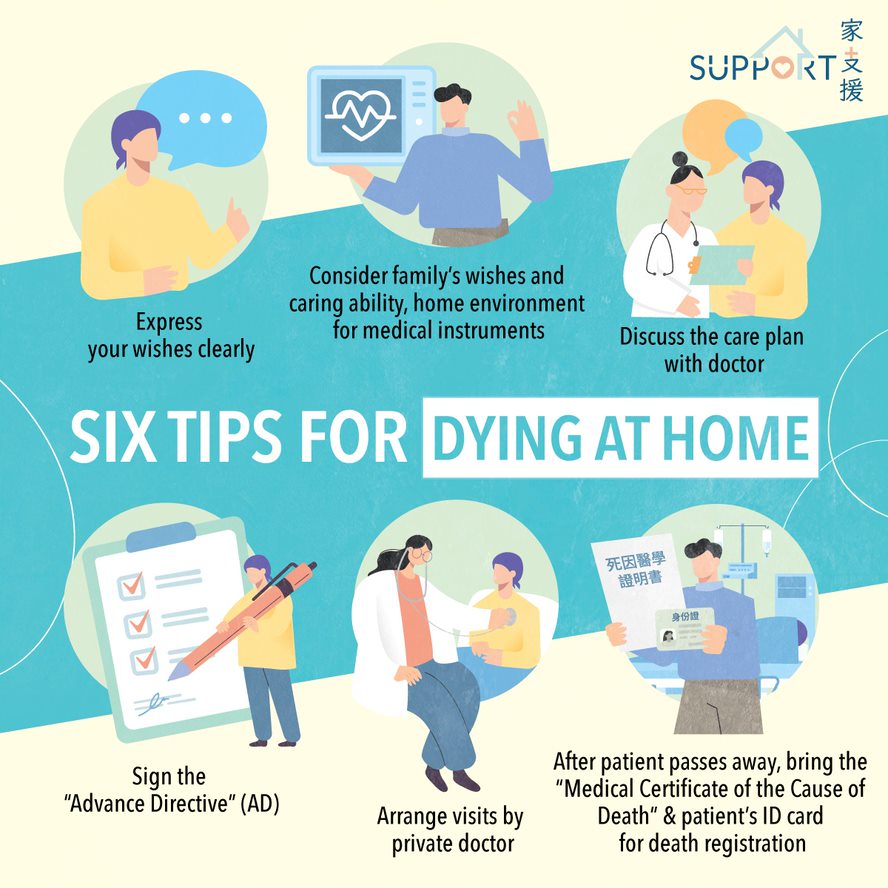
1. For the patient: What are my last wishes?
- What are my thoughts of the “Die-at-Home" plan?
- Is it more ideal than dying in a hospital?
- How do my carer(s) and family feel about this?
2. For carers and families: Aspects worth considering
- What are my own wishes? Are they similar to the person under my care?
- Am I physically able for the choice?
- How well equipped is the home to support this decision?
- Are there any family members who are willing to care for the patient full-time?
If all these can be answered, it would greatly help the doctor in charge. You need to inform your doctor about these answers at any time, such as during the next appointment.
Caring for a patient with severe or terminal illness is not an easy task. As they near the end of life, mobility and day-to-day activities have to be taken care of by at least 2 family members. Discussions and agreements between both patient and caregiver will be the first priority.
3. Prepare the home environment
- With the space there is now, is the home capable of supporting the patient’s wish of passing away at home?
- Is there enough space for medical equipment to be placed near or around the patient?
Equipment such as an electrocardiogram to measure heart rate and an oxygen generation machine will have to be able to fit in the room or space where the patient is resting.
4. Informing health professionals about the last wish
- Health professionals such as the oncologist, GP and nurses should have full knowledge of both the patient’s and carer’s wishes as part of the patient’s support network.
- Discussions should be tailored towards how the patient wants to be cared for if the situation changes down the line.
*If it was decided to follow the pass-at-home route, once the heart stops beating, insufficient time to start life-saving procedures such as CPR will result in death. However, health professionals will treat the wishes of the carer and patient with utmost respect. *
5. Signing the Advance Directive
- The Advance Directive is a set of medical instructions for the medical team that is legally binding. It is a physical document that must be kept safely after signing.
- Patient has to be at least 18 years old to sign this Advance Directive. The only other thing required is that they are conscious and of sound mind.
- Besides patient's signature, two guarantors which do not benefit from them will are required to give theirs. One of the guarantors must be a Hong Kong-registered doctor.
6. Arranging at-home consultation
- Finding a private-practice doctor is one of the steps needed in this process. The doctor will perform what the patient would expect of a normal health check-up, but at their home.
- A typical checkup will be performed at least once every 2 weeks, or at a frequency that both you and your doctor agree to.
- The doctor should also be willing to sign a Certificate of Death for the patient. Hong Kong law states that signing this is only for the visiting doctor responsible or another one who performed a checkup at least 2 weeks before the passing of the patient.
7. At the very end:
- When the patient enters the last moments before passing away, family members need to contact their designated private-practice doctor as soon as possible. The doctor will come and assess the patient. They will assess and certify the death of the patient, e.g. using ECG to certify there is no more heartbeat. After certifying death, the doctor will sign the "Medical Certificate" as required by law.
- Family members then need to notify mortuary staff to arrange transportation of the deceased’s body from the home to a funeral parlour. Family members are also required to bring the medical certificate and patient’s ID card to register death at the Death Registry within 24 hours after death.


